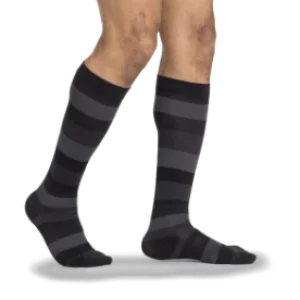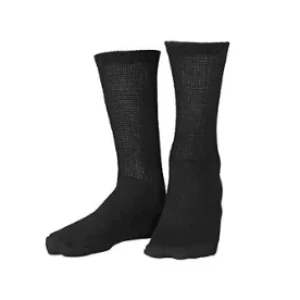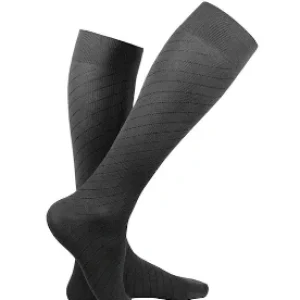Compression Stockings Brampton
Compression stockings are designed to improve circulation and reduce swelling. It also provides relief from various leg-related health issues. Vodden Medical Pharmacy offers a wide range of compression stockings. We have options for different needs and preferences.
Find the right compression for you.
With compression options ranging from over the counter, prescription, or specific lifestyle products, we carry a wide selection of what you need.

Light compression socks at 8-15 mmHg are perfect for everyday use to help avoid the feeling of tired, heavy legs. They are recommended for those who like to travel or spend a lot of time on their feet.

Moderate compression socks at 15-20 mmHg are ideal for everyday use to help provide relief from swelling, aching, varicose veins, as well as helping to prevent deep vein thrombosis while travelling.

Firm compression hosiery at 20-30+ mmHg are often referred to as Class 1. This category of compression requires a RX (prescription) and accurate measurements from a certified fitter to help promote venous blood flow as well as help prevent and relieve painful symptoms.

Diabetic Socks are designed with extra cushioning, minimal or no seams, and with non-binding fabric to help individuals with diabetes, anyone with ankle or foot swelling, and those requiring special foot care would also benefit from this style of sock.

Don’t forget to pack your favourite compression socks to help keep your legs feeling healthy during long trips in the car or on a plane. Let the adventures begin!

Looking for a bit more support and performance-based compression wear? Our selection of sports compression products offer assistance with recovery, muscle stabilization, and materials designed for quick drying.
What Are Compression Stockings?
Compression stockings are specialized garments that apply gentle pressure to the legs. It helps to improve blood circulation. They commonly manage varicose veins, swelling, and poor circulation. With graduated pressure, they help prevent blood from pooling in the lower legs. It offers relief and support. These stockings are essential for promoting leg health. It helps to reduce discomfort and prevent complications related to poor circulation.
Why Choose Compression Stockings?
- Improve blood circulation and reduce leg swelling.
- Provide relief from conditions like varicose veins and edema.
- Alleviate discomfort and fatigue from standing or sitting for long hours.
- How Do Compression Stockings Work?
Compression stockings apply graduated pressure to the legs, with the highest pressure at the ankle, gradually decreasing as you move up the leg. This compression helps to promote blood flow back toward the heart, reducing swelling, improving circulation, and alleviating discomfort.
Why Choose Vodden Pharmacy For Compression Stockings?
Vodden Medical Pharmacy offers high-quality compression stockings in Brampton. We have trusted brands for the best support. Our pharmacists help you choose the right pair. We make sure you get comfort and the best results.
Expert Guidance
Our pharmacists provide professional advice to help you choose the right fit.
Wide Selection
We offer a variety of compression stockings to meet different needs and preferences.
Quality Products
We offer a variety of compression stockings to meet different needs and preferences.
Top-Class Service
Our team offers personal support for your leg health. We are here to help with your concerns.
Proper Sizing
Ensure you choose the correct size for maximum comfort and effectiveness.
Consistent Use
Wear compression stockings regularly, especially during long periods of standing or sitting.
Care and Maintenance
Wash and maintain your compression products properly to preserve their elasticity and durability.
Other Services
Our Top-class Pharmaceutical Services
We offer comprehensive pharmacy services to support your health and well-being. Our team is dedicated to providing expert care with precision and professionalism.

Prescription Refill
Get quick and easy prescription refills in-store. We make sure you have fast access to your medication.

Compounding
As a compounding pharmacy, we create personalized medications tailored to your doctor's prescription.

Minor Ailments
We offer simple solutions for colds, allergies, and headaches. We also help with other minor health issues.

Compliance Packaging
Our compliance packaging helps you take the right medicine on time. It comes in easy, pre-filled packs.

Home Healthcare Supplies
We offer ankle, knee, wrist, and elbow braces and supports to help ease joint pain symptoms.

Medication Reviews
Consult with our pharmacists for a MedsCheck to review your current medications. We will address any concerns you may have.
Our in-store specialists are trained to assist you with your compression fittings and overall needs.
Visit us today to get the help you need.
We Provide The Best Medical Care For Your Family
General Inquiries? Find Your Answers Here
Find answers to all your questions in our comprehensive FAQ section, providing helpful information and guidance.
Compression stockings are specialized garments that apply consistent pressure to your legs to enhance circulation and prevent swelling. They are used to address poor circulation, varicose veins, and leg fatigue.
Compression stockings apply graduated pressure, which helps push blood upwards toward the heart. This process prevents blood from pooling in the lower legs and aids in efficiently returning blood to the heart.
Compression stockings are ideal for people with circulation issues, varicose veins, swelling, leg fatigue, or those who stand or sit for long periods. They can also be beneficial for pregnant individuals or people recovering from surgery.
Choosing the right compression stockings in Brampton involves considering your medical condition, comfort level, and type of activity. Our pharmacists can assist you in selecting the correct compression level and size to meet your needs.
Compression stockings are designed to be comfortable when properly fitted. They may feel tight at first but are generally well-tolerated once worn regularly. If you experience any discomfort, it could indicate an improper fit or compression level.
To prolong the lifespan of your compression stockings, wash them regularly using a mild detergent in cold water. Avoid fabric softeners and bleach, and air dry them to maintain their elasticity and prevent damage.
Typically, compression stockings are not necessary while sleeping unless advised by your healthcare provider. However, they can be worn overnight if you experience severe swelling or other circulation issues.
Vodden Medical Pharmacy offers a wide range of high-quality compression stockings tailored to fit your needs. Our knowledgeable team ensures you receive expert advice and personalized service for the best results.
Schedule Your Appointment Today
Book an appointment with our specialists to find the perfect compression stockings for your needs. Our team will ensure a proper fit and provide expert advice for optimal comfort and support.
Our Blogs
Latest News & Articles
Dive into our blogs for insightful articles, health advice, and the latest trends to support your wellness journey.
Top 10 Trusted Pharmacies In Brampton, Ontario For 2025
In today's fast-paced world, pharmacies play a critical role far beyond dispensing medication. They are essential healthcare touchpoints...
How To Choose A Reliable Compounding Pharmacy In Brampton?
In today's modern healthcare landscape, personalization is more important than ever. Patients often require medications that are not...
How Pharmacies Are Adapting To The Digital Revolution?
The pharmacy industry has long played a vital role in community health. Traditionally associated with in-store visits and...




